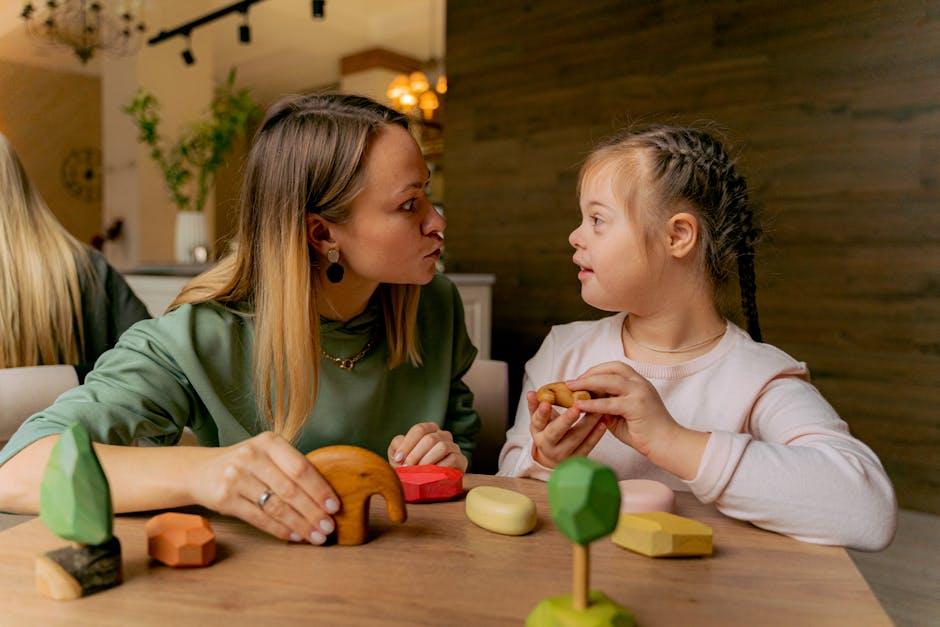Getting your family on board with a new idea, habit, or plan can often feel like navigating a maze—full of twists, turns, and unexpected detours. Whether you’re hoping to introduce healthier meals, start a new routine, or embark on a shared project, gaining everyone’s support is key to success. But how do you transform hesitation into enthusiasm, reluctance into cooperation? In this article, we’ll explore practical strategies and thoughtful approaches to unite your loved ones around common goals, creating a sense of teamwork that turns individual efforts into a shared journey.
Table of Contents
- Understanding Family Dynamics to Foster Cooperation
- Communicating Clearly and Empathetically to Build Trust
- Identifying Shared Goals and Aligning Expectations
- Creating Inclusive Decision-Making Opportunities
- Building Positive Habits Through Consistent Support
- Q&A
- Closing Remarks

Understanding Family Dynamics to Foster Cooperation
Every family operates like its own little ecosystem, where each member plays a crucial role in maintaining harmony. Recognizing the personalities, communication styles, and emotional needs unique to each person allows for tailored approaches that encourage collaboration rather than conflict. Instead of imposing decisions, focus on active listening and empathy to uncover underlying motivations and concerns, transforming potential resistance into meaningful participation.
Creating an environment where everyone feels valued requires more than just good intentions—it demands conscious effort and strategic practices. Consider incorporating these simple yet effective strategies:
- Shared goals: Establish clear, common objectives that resonate with everyone’s interests.
- Role clarity: Define responsibilities to prevent confusion and overlap.
- Conflict resilience: Foster open dialogue to address disagreements constructively.
- Regular check-ins: Maintain connection and course-correct when needed.
| Family Member | Preferred Communication | Motivation Driver | Suggested Approach |
|---|---|---|---|
| Parent | Direct & Detailed | Stability | Provide Clear Plans |
| Teenager | Casual & Visual | Autonomy | Offer Choices |
| Child | Simple & Engaging | Fun & Recognition | Use Games & Praise |

Communicating Clearly and Empathetically to Build Trust
Building trust within the family starts with thoughtful communication that bridges understanding and respect. When you engage, focus on listening more than speaking—this creates a safe space where everyone feels heard. Use open-ended questions to invite honest feelings and perspectives without judgment. Empathy grows when you acknowledge emotions directly: phrases like “I see why you feel that way” or “It makes sense that you’re concerned” validate their experience and soften any resistance. Remember, tone and body language speak louder than words; a calm demeanor combined with sincere eye contact can make all the difference in fostering connection.
- Be patient: Allow time for the conversation to unfold naturally without pushing for immediate answers.
- Share your story: Vulnerability encourages openness, so express your feelings honestly.
- Stay solution-focused: Emphasize teamwork and the shared goal of harmony rather than blame.
To guide conversations effectively, refer to the table below that outlines key empathetic phrases alongside their purposes and impact:
| Phrase | Purpose | Impact |
|---|---|---|
| “Help me understand your view” | Invites explanation | Builds mutual respect |
| “It sounds like you’re worried about…” | Reflects emotions | Validates feelings |
| “What can we do together to solve this?” | Focuses on collaboration | Encourages teamwork |

Identifying Shared Goals and Aligning Expectations
Bringing everyone onto the same page starts with understanding what really matters to each family member. By openly discussing individual hopes and concerns, you create a foundation of trust that turns potential conflicts into collaborative solutions. Use a family meeting or casual gathering as a safe space to encourage honest sharing. This ensures no voice is overlooked. Remember, shared goals often hide beneath personal motivations—zoom in to discover these hidden connections and foster a deeper sense of unity.
Once these insights are on the table, craft a roadmap everyone can rally around. Here’s a simple way to keep track of your family’s aspirations and concerns:
| Family Member | Key Goal | Concerns | Expected Role |
|---|---|---|---|
| Mom | Balanced budget | Unexpected expenses | Financial planner |
| Dad | More family time | Work schedule conflicts | Coordinator |
| Teenager | Independence | Feeling unheard | Voice of youth |
- Clarify roles to empower each person.
- Set realistic timelines that everyone agrees on.
- Check in regularly to adjust expectations as needed.
Aligning with this level of clarity boosts cooperation and turns family dreams into actionable plans—building a resilient team ready to tackle challenges together.

Creating Inclusive Decision-Making Opportunities
Encouraging every family member to have a voice in decisions nurtures a culture of respect and collaboration. It’s vital to create safe spaces where opinions can be shared freely without judgment. Start by setting regular family meetings that rotate leadership roles, so each person feels valued and responsible. Incorporating tools like voting systems, suggestion boxes, or even digital polls can make participation engaging and equitable, ensuring that everyone’s perspective shapes the direction your family takes.
To streamline decision-making and avoid overwhelm, consider establishing clear guidelines that balance structure with flexibility. Here are some practical ways to include everyone effectively:
- Set clear agendas: Helps focus discussions and respect time.
- Encourage active listening: Reinforces understanding and reduces conflicts.
- Rotate decision types: From daily chores to major plans, so everyone has a chance to lead.
- Celebrate consensus: Recognize and appreciate collaborative choices to build unity.
| Technique | Benefit |
|---|---|
| Family Votes | Democratic decisions build fairness |
| Suggestion Box | Encourages shy members to contribute |
| Role Rotation | Empowers diverse leadership |

Building Positive Habits Through Consistent Support
Creating lasting change within a family is much easier when everyone feels supported and included. Begin by fostering an environment where positive habits are celebrated, no matter how small. Open communication plays a crucial role here — invite family members to share their own goals and challenges, making the journey a shared experience. Encourage regular check-ins, whether it’s a quick morning chat or an end-of-day reflection, to maintain momentum and adjust strategies together.
Another effective approach is to introduce visual aids that help track progress and motivate participation. Consider using a simple habit tracker chart that highlights each member’s contributions, creating a sense of friendly collaboration without pressure. The following table outlines an example of ways to encourage consistent support:
| Method | Description | Benefit |
|---|---|---|
| Family Meetings | Set weekly time slots to discuss progress | Enhances accountability and motivation |
| Shared Reward System | Offer small group incentives for milestones | Builds collective excitement and engagement |
| Role Modeling | Lead by example with consistent habit practice | Encourages others to follow naturally |
Q&A
Q&A: How to Get Your Family on Board
Q: Why is it important to get my family on board with new ideas or changes?
A: When your family supports a new idea or change, it creates a sense of unity and shared purpose. This can make the process smoother, reduce resistance, and increase the chances of success, whether it’s adopting healthier habits, moving to a new home, or starting a family project.
Q: What’s the first step in encouraging family buy-in?
A: Start by having an open conversation. Share your thoughts clearly and listen to their perspectives. Understanding concerns and motivations helps everyone feel valued and sets the stage for collaboration.
Q: How can I present my ideas without sparking conflict?
A: Use “I” statements to express how you feel and why the change matters to you. Avoid blaming or criticizing, and focus on common goals. For example, say “I think this could help us save money” instead of “You never want to save money.”
Q: What should I do if a family member is resistant?
A: Patience is key. Acknowledge their feelings without immediate judgment, and ask questions to understand their hesitation. Sometimes resistance comes from fear of change or uncertainty, so offering reassurance can help.
Q: How do I involve everyone in the decision-making process?
A: Encourage participation by inviting ideas and suggestions. Make it a collaborative effort rather than a one-sided decision. This builds ownership and increases willingness to follow through.
Q: Are there any practical tools that can help?
A: Visual aids like charts, pros and cons lists, or timelines can clarify the plan and expectations. Family meetings or casual check-ins keep communication open and progress on track.
Q: What if family members have conflicting interests?
A: Look for compromises or win-win solutions. Emphasize shared values and the bigger picture. Sometimes prioritizing what’s best for the family as a whole can help bridge individual differences.
Q: How long does it usually take to get everyone on board?
A: It varies. Some families may embrace change quickly, while others need more time to process and adjust. Consistent communication and empathy will gradually foster alignment.
Q: Can getting family on board improve relationships beyond the change itself?
A: Absolutely. Collaboration builds trust, strengthens bonds, and improves overall family dynamics. When everyone feels heard and respected, it creates a more supportive environment for future challenges.
Q: What’s the biggest takeaway for persuading your family effectively?
A: Approach the process with empathy, clarity, and patience. Remember, it’s about building consensus, not winning a debate. When everyone feels included and understood, change becomes a shared journey rather than a solo mission.
Closing Remarks
Bringing your family on board isn’t just about convincing—it’s about connecting. By listening with empathy, sharing your vision clearly, and embracing everyone’s perspectives, you create a collaborative journey rather than a solo mission. Remember, the true power lies not in winning agreement, but in building understanding together. So take a deep breath, open the door to honest conversations, and watch how unity transforms challenges into shared victories. Here’s to turning “me” into “we,” one step at a time.








Leave feedback about this